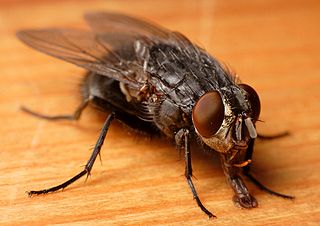
The Calliphoridae are a family of insects in the order Diptera, with almost 1,900 known species. The maggot larvae, often used as fishing bait, are known as gentles. The family is known to be polyphyletic, but much remains disputed regarding proper treatment of the constituent taxa, some of which are occasionally accorded family status.

Cluster flies are flies of the genus Pollenia in the family Polleniidae. Unlike the more familiar blow flies, such as the bluebottle genus Phormia they do not lay eggs in human food. They parasitise earthworms; the females lay their eggs near earthworm burrows, and the larvae then feed on the worms. But the biology of this group is relatively poorly known and a few have been recorded from other hosts including caterpillars and bees.

The Dryomyzidae are a small family of flies ranging from 4–18 mm long, with prominent bristles, and yellow to brown or rust-yellow coloring. The wings are very large. The subcosta is complete and well separated from vein 1. Larvae feed on decaying organic matter - carrion, dung, and fungi. The prelambrum protrudes from the oral cavity. Vibrissae are absent and the postvertical bristles are divergent.

Bengalia is a genus of blow flies in the family Calliphoridae with one authority considering the genus to belong to a separate family Bengaliidae. These bristly and, unlike the greens and blues of most calliphorids, dull coloured flies, are especially noted for their relationship to ants. Little is known of their biology and life-cycle, although adults of many species are kleptoparasitic on ants and will snatch food and pupae being carried by ants or feed on winged termites. The apt name “Highwayman Fly” was given by an early observer of their way of robbing ants. Very little is known about their breeding habits. The genus is found in the Afrotropical and oriental region with one species from Australia possibly a recent introduction.

Calliphora vicina is a member of the family Calliphoridae, which includes blow flies and bottle flies. These flies are important in the field of forensic entomology, being used to estimate the time of a person's death when a corpse is found and then examined. C. vicina is currently one of the most entomologically important fly species for this purpose because it arrives at and colonizes a body following death in consistent timeframes.

Lucilia is a genus of blow flies in the family Calliphoridae. Various species in this genus are commonly known as green bottle flies.

The Miltogramminae are a subfamily of the family Sarcophagidae. They are kleptoparasites of solitary bees and solitary wasps.

Calliphora livida is a member of the family Calliphoridae, the blow flies. This large family includes the genus Calliphora, the "blue bottle flies". This genus is important in the field of forensic entomology because of its value in post-mortem interval estimation.

Melinda is a genus of flies in the family Calliphoridae. In general little is known of their biology. A few species have been reared from snails. One – Melinda gentilis – is parasitic in the snails Helicella virgata and Goniodiseus rotundata and Melinda itoi is a parasite of the snail Acusta despecta sieboldiana.

Linnaemya is a genus of flies in the family Tachinidae.

Actia is a genus of large flies in the family Tachinidae.

Pales is a genus of flies in the family Tachinidae.

Dexiinae is a subfamily of flies in the family Tachinidae.

Exoristinae is a subfamily of flies in the family Tachinidae. Most species are parasitoids of caterpillars.

Tachininae is a subfamily of flies in the family Tachinidae.
Cosmina is a genus of flies in the family Rhiniidae.

Rhiniidae is a family of flies in the order Diptera, and formerly included in the Calliphoridae. There are around 30 genera and 370 described species in Rhiniidae.



















